

Zynga reveals Zynga API for third-party developers. Zynga reveals Zynga API for third-party developers Zynga’s chief engineer Kostadis Roussos announced the new Zynga API at today’s Zynga Unleashed event available to third party developers.

The API is designed to cut out backend servers by integrating Zynga’s standard game services. Zynga Slots was the test game for this API, but he says the API is rolling it out to other companies now. The API was revealed at the end of Roussos’s presentation during Zynga Unleashed, bookending a discussion about the technology Zynga employs to build its games. Roussos also mentioned how the company uses zCloud, the world’s largest hybrid cloud server to launch a game and grow it to up to 10 million players in a week. Stop the CAPTCHA Madness! Foamicate.com. Buildor / Pro. OAuth. For MediaWiki's (the software used by Wikipedia) OAuth support, see mw:Help:OAuth OAuth is an open standard for authorization, commonly used as a way for Internet users to log into third party websites using their Microsoft, Google, Facebook or Twitter accounts without exposing their password.[1] Generally, OAuth provides to clients a 'secure delegated access' to server resources on behalf of a resource owner.
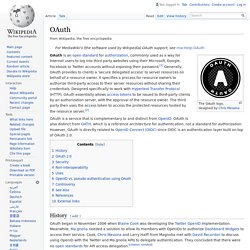
It specifies a process for resource owners to authorize third-party access to their server resources without sharing their credentials. Designed specifically to work with Hypertext Transfer Protocol (HTTP), OAuth essentially allows access tokens to be issued to third-party clients by an authorization server, with the approval of the resource owner. The third party then uses the access token to access the protected resources hosted by the resource server.[2] OAuth is a service that is complementary to and distinct from OpenID. History[edit] OAuth 2.0[edit] Security[edit] Uses[edit] Www.voki.com/create.php. Embedly. Welcome to Survey Monkey! Create a free API Console for your developer portal. By creating and deploying API proxies, you are bringing new APIs into the world.
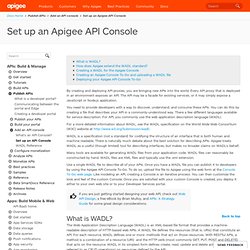
Every API proxy that is deployed in an environment exposes an API. The API may be a facade for existing services, or it may simply expose a JavaScript or Node.js application. You need to provide developers with a way to discover, understand, and consume these APIs. You can do this by creating a file that describes your API in a commonly-understood way.
There a few different languages available for service description. WADL is a specification (not a standard) for codifying the structure of an interface that is both human and machine readable. Real-Time Intelligence Solutions. Point.
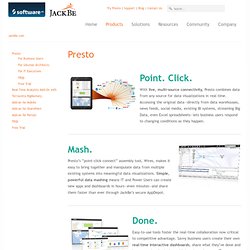
Click. With live, multi-source connectivity, Presto combines data from any source for data visualizations in real time. Accessing the original data—directly from data warehouses, news feeds, social media, existing BI systems, streaming Big Data, even Excel spreadsheets—lets business users respond to changing conditions as they happen. OAuth 2.0 for Google APIs. One of the most exciting things about the architecture of the web is how easily it supports mashups—URLs, IFRAMEs, XHR, and more make it easy to build great new services on top of building blocks from others.
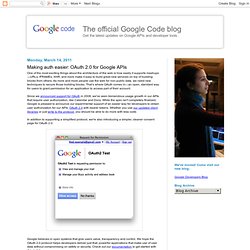
As more and more people use the web for non-public data, we need new techniques to secure those building blocks. That’s where OAuth comes in—an open, standard way for users to grant permission for an application to access part of their account. Since we announced support for OAuth in 2008, we've seen tremendous usage growth in our APIs that require user authorization, like Calendar and Docs. While the spec isn't completely finalized, Google is pleased to announce our experimental support of an easier way for developers to obtain user authorization for our APIs: OAuth 2.0 with bearer tokens.
Whether you use our updated client libraries or just write to the protocol, you should be able to do more with less code. By Andrew Wansley, Google Developer Team. Making auth easier: OAuth 2.0 for Google APIs. Launchpad. SIMILE Widgets. Echo Community Wiki / Echo Packages. Hyperpublic Developer Site. Www.voki.com/create.php. Anthologize. API Management, Infrastructure and Strategy - Mashery. Backlink Builder. Developers Overview. SearchMonkey - Site Owner Overview. SearchMonkey is fundamentally about transforming the way search results are displayed.
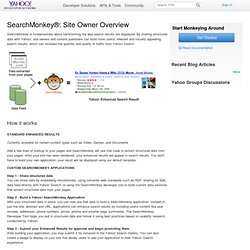
By sharing structured data with Yahoo! , site owners and content publishers can build more useful, relevant and visually appealing search results, which can increase the quantity and quality of traffic from Yahoo! Search. How it works Currently available for certain content types such as Video, Games, and Documents Add a few lines of markup to your pages and SearchMonkey will use that code to extract structured data from your pages. Step 1 - Share structured data You can share data by embedding microformats, using semantic web standards such as RDF, sharing an XML data feed directly with Yahoo!
Step 2 - Build a Yahoo! With your structured data in place, you can now use that data to build a SearchMonkey application. Step 3 - Submit your Enhanced Results for approval and begin promoting them After building your application, you may submit it for inclusion in the Yahoo! Tools & Documentation. Dipity - Find, Create, and Embed Interactive Timelines. About the TalkShoe company that creates Community Calls. Gravatar - Globally Recognized Avatars.
Echo - Build Highly Social Real-time Apps.